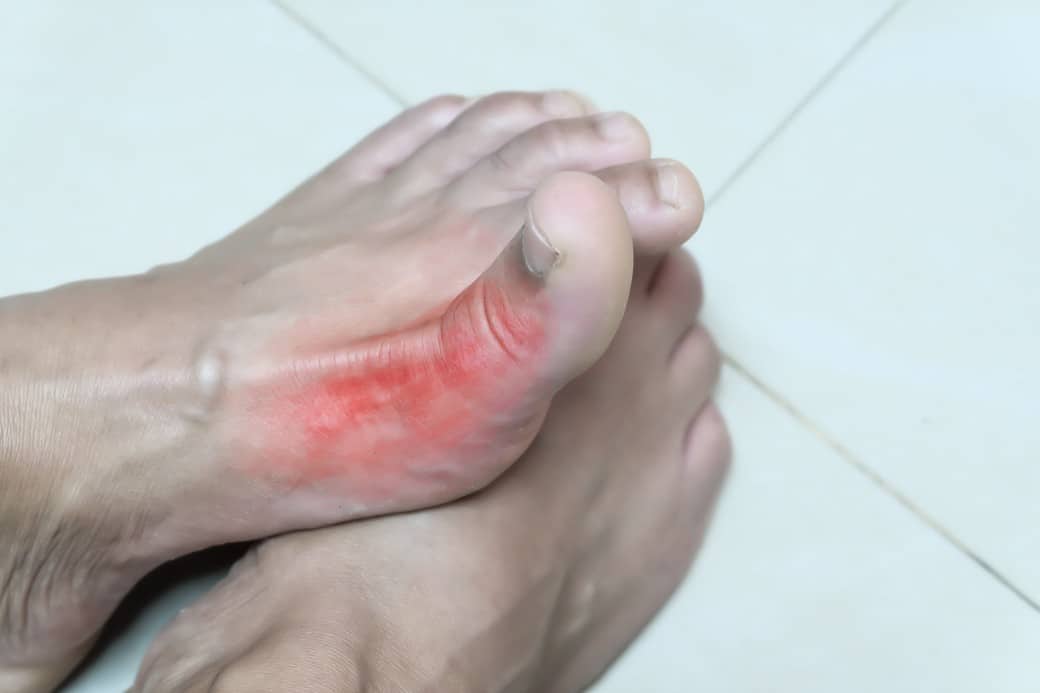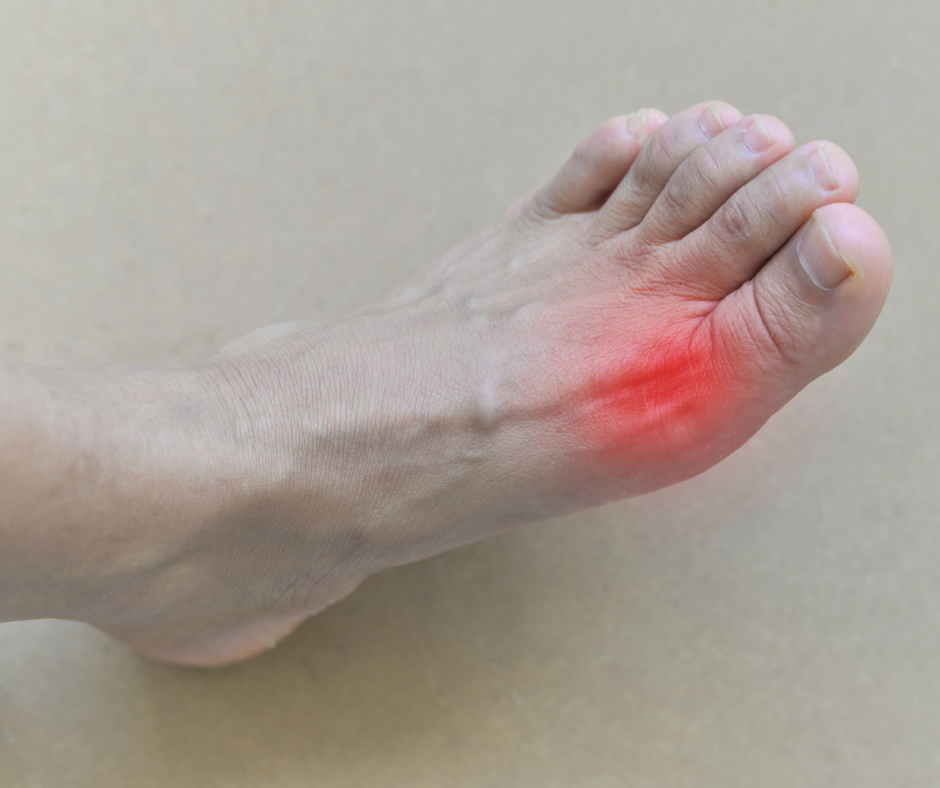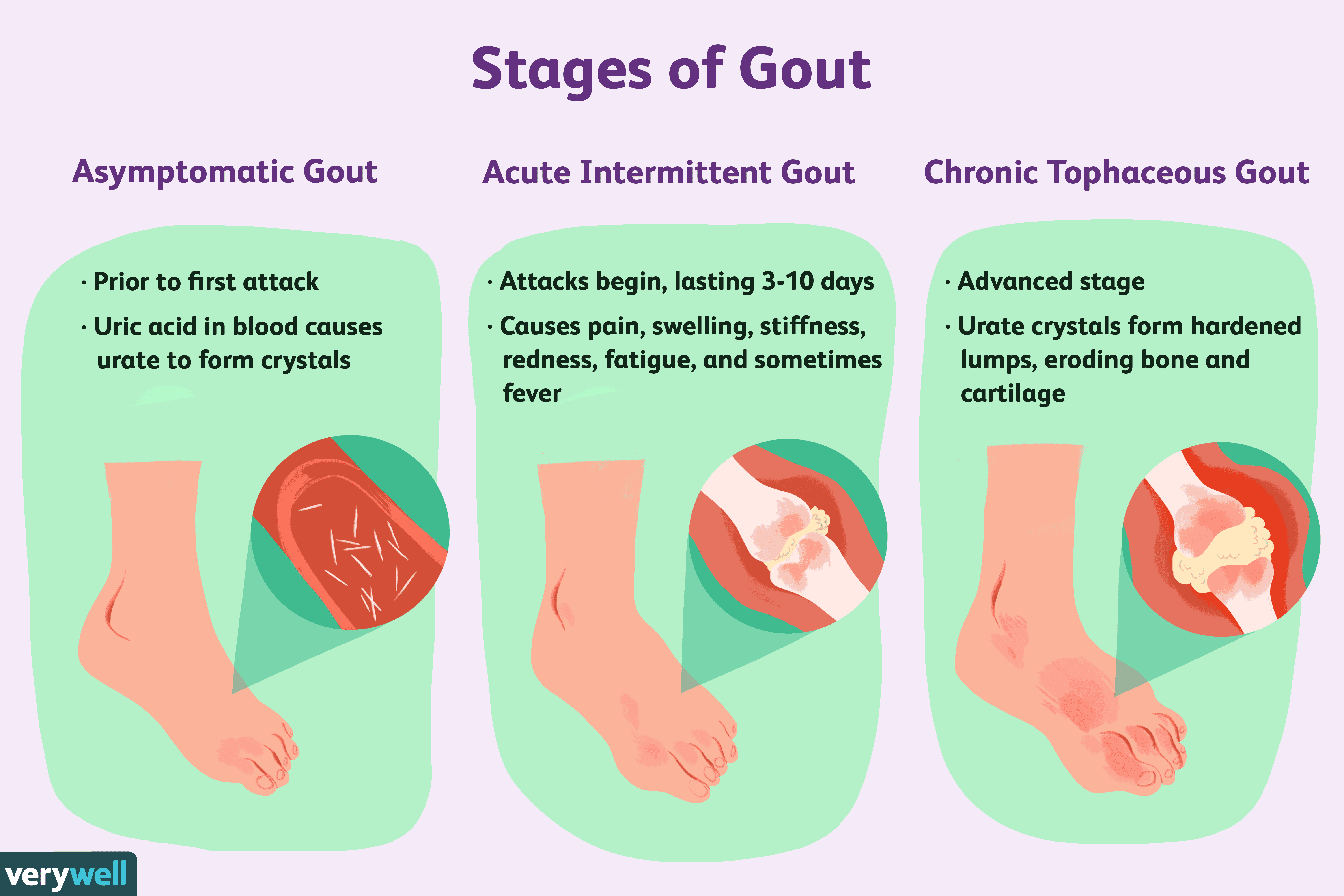When To See A Doctor
Gout occurs without warning. Anyone experiencing intense pain on the big toe, followed by warmth, tenderness, redness or discoloration, should immediately seek medical attention.
If a person does not receive treatment for gout, it can lead to joint damage over time, including bone erosions and arthritis.
What Are The Main Causes Of Gout
One of the main causes of painful gout attacks is the sudden increase of uric acid in your blood. When the level of uric acid increases, it tends to develop into some form of urate crystals and gets deposited over your joints. One of the major sources for higher levels of production of uric acid is either through dietary sources or through the increase in the synthesis of uric acid in the human body itself. When the crystals form a deposit over the joints, it causes severe to extreme pain in the affected area.
Suggested article: What Is Gout? Symptoms, Stages and Treatment Of Gout
People having the habit of drinking too much alcohol and having lots of fish and meat are prone to get affected by gout attacks as these drinks and food come with a lot of dangerous gout causing chemicals called purines. When you intake a lot of purines, these purines are broken down into urate crystals that get deposited in the joints, knees and ankles to cause gout. Another major cause of gout is by genetic ways, as there are chances of you getting attacked by gout, if any of your members in your family have already been diagnosed with gout.
Which Foods Cause Gout
Foods high in purines from animal and seafood sources are thought to be a key element of increasing uric acid precursors. Interestingly, purines can also be found in high concentrations in vegetables such as beans and mushrooms, but these have not been found to be related to the risk of hyperuricemia.
New evidence over the last decade has shown that some of the foods that were previously thought to be associated with gout, like meat, may not have such a strong relationship as originally thought. Overall, your gout risk may be raised by consuming large quantities of:
- Some seafoods, like shellfish, shrimp, tuna, mussels, lobster, sardines and salmon
- Red meats like bacon, liver, beef, pork, turkey, veal and lamb
- High-fructose corn syrup, which is often found in processed foods including biscuits, syrups, chutneys and sauces, though the evidence is mixed on this one with only one American study finding a relationship between high consumption and gout
Before you decide to cut out food groups from the list above, according to Arthritis Australia, there is little evidence that avoiding these purine-rich foods can significantly reduce gout attacks and by cutting them out, you may miss out on important vitamins and minerals, particularly when it comes to meats and seafood. We recommend making these decisions together with your GP, dietitian or nutritionist.
Read Also: Where Does Gout Attack The Foot
How Can I Manage My Gout And Improve My Quality Of Life
Gout affects many aspects of daily living, including work and leisure activities. Fortunately, there are many low-cost self-management strategies that are proven to improve the quality of life of people with gout.
For gout in particular:
- Eat a healthy diet. Avoid foods that may trigger a gout flare, including foods high in purines , and limit alcohol intake .
CDCs Arthritis Program recommends five self-management strategies for managing arthritis and its symptoms. These can help with gout as well.
Points To Remember About Gout

- Gout is a type of arthritis that causes pain and swelling in your joints, usually as flares that last for a week or two, and then go away.
- With early diagnosis, treatment, and lifestyle changes, gout is one of the most controllable forms of arthritis.
- The most common symptom of gout is pain in the affected joint, such as the big toe.
- Your doctor may recommend taking medications to manage the cause of your gout and treat active gout flares, and making changes to your diet and lifestyle.
Recommended Reading: Is Onion Bad For Gout
Common Symptoms Of Hashimotos Disease
What Is Hashimotos Disease? Hashimotos disease is a disease that affects the thyroid gland and could damage the thyroid function another name for it is Hashimotos Thyroiditis. Hashimoto disease is an autoimmune disorder, and it is a condition in which the immune system attacks a small gland at the base …
What Does The Future Hold For Gout
Active research is ongoing in a variety of fields related to gout and hyperuricemia. Scientists have found that high animal protein slightly increased the risk for gout. New drugs are being developed that may be more versatile and safe in treating the elevated uric acid levels in patients with chronic gout.
You May Like: Is Eggplant Bad For Gout
Where Does A Gout Attack Occur
Gout often attacks the largest joint in your big toe. However, it can also attack the foot, ankle knees, hands, or wrists. Intense pain, redness, and swelling can start with no warning, although you may have warning signs of an impending attack. If you start to feel tingling, burning, or itching in a joint, your body is giving you a warning signal that a flare-up is imminent.
How Will Gout Affect Me
Attacks can vary from person to person. Some people only have an attack every few years, while others have attacks every few months.
Without medication attacks tend to happen more often and other joints can become affected.
Having high urate levels and gout for a long time can lead to other health problems, including:
- narrowing of the arteries – which can lead to an increased risk of stroke or heart attacks or other heart problems
- osteoarthritis, which occurs when the urate crystals and hard tophi cause joint damage.
- an increased risk of developing kidney disease or worsening of the condition if you already have it
- kidney stones
- an increased risk of some cancers, especially prostate cancer
- mental health problems, including depression
- underactive thyroid
- erectile dysfunction in men.
If you take medication to lower your urate levels, and have a healthy diet and lifestyle, most of the damage and complications caused by gout can be stopped.
Treatments for gout are incredibly successful. There are two main parts to treating gout, which are:
- treating the acute attack
- treatments to prevent future attacks.
You May Like: Gout Like Symptoms In Knee
How Do I Remedy The Pain And Symptoms Of Gout In My Feet
If youre in the middle of a gout flare, your first line for reducing the immediate symptoms is medical management. Often, this involves anti-inflammatory drugs , colchicine or corticosteroids though this should be carefully selected for you by your GP or specialist with special considerations to your medical conditions and any other medications that you may be taking.
After your flare has settled, some after-effects of your gout may remain, particularly if there has been damage to the big toe joint, the joint capsule, or the surrounding tissues and ligaments. Here, we play a big role in helping improve your comfort and foot function using offloading padding, custom foot orthotics, and ensuring that your shoes are supporting good, comfortable foot function and not worsening your symptoms.
Occasionally, we see patients that have altered their natural gait pattern so much during a gout flare to try to reduce their pain that other pains elsewhere in the feet and legs have resulted. We can help you with this as well as any sores, wounds, callus or other skin problems that develop around the joint.
First Foods That Can Help
- There are actually several types of foods that may help protect against gout attacks. These include low-fat dairy foods, complex carbohydrates, coffee, and fruits, especially citrus fruits. You should also be sure to get 12 to 16 cups of fluid daily.
- You don’t necessarily have to drink only wateryou can choose non-sweetened juice, tea, and coffee too.
- Any kind of fluid that keeps that blood flowing and urine flowing is a good choice, says Lona Sandon, PhD, RDN, an assistant professor of clinical nutrition at the University of Texas Southwestern Medical Center in Dallas.
Next up: The foods to avoid. Read on for a list of potentially problematic eats.
Scallops are okay for an occasional indulgence, but you should cut back on themand all types of meat and seafoodduring a flare-up, says Sandon. These animal foods are rich in purines, which your body breaks down into uric acid.
You have a little more freedom in your food choices when your gout is at bay, but its still a good idea to keep meat and seafood intake to a minimum4 to 6 ounces daily at most.
All meat is not created equal when it comes to purine content: White meat is generally better than red.
But it is okay to eat some types of red meat once in a while. Youre a bit better off if your occasional indulgence is beef or pork rather than lamb, says Dr. Zashin.
And lamb chops are a better choice than leg meat.
Organ meats, such as liver, kidneys, and sweetbreads, are a major no-no.
Recommended Reading: Signs And Symptoms Of Gout In Big Toe
Acute Attack Pain Management
Home remedies. Reducing inflammation during an acute gout attack will provide pain relief.
- Ice. Apply ice to the affected area to reduce swelling. Do not apply ice directly to the skin. Use an ice pack or wrap a towel around the ice. Apply ice for about 20 minutes at a time.
- Elevate. Frequently raise and keep the affected area above the level of the heart.
- Rest. Move the affected area as little as possible while symptoms are present.
- Over-the-counter non-steroidal anti-inflammatory medicines. If the gout attack is mild, anti-inflammatory drugs available without a prescription may relieve pain. Because there are serious side effect of using non-steroidal anti-inflammatory drugs even the over-the-counter strength be sure to check with your doctor before taking them.
Prescription medications. Your doctor may recommend a prescription-strength non-steroidal anti-inflammatory medicine such as indomethacin.
Colchicine is also given to reduce inflammation during an acute gout attack. This drug has recently been approved by the Federal Drug Administration for treatment of gout. Like all medications, colchicine has side effects that you will need to discuss with your doctor.
Your doctor may also prescribe corticosteroids for acute gout attacks. These are strong anti-inflammatory medications that can be taken either in pill form, intravenously, or injected into the painful joint. Cortisone may improve the severe inflammation very quickly.
How Do You Get Gout

There are a few risk factors that increase your chances of getting gout or of triggering a gout attack. They include:
- Diet high in purines, including red meat, organ meats, and seafood
- Drinking a lot of sugary beverages
- Alcohol consumption
- Medical issues such as high blood pressure, kidney disease, and diabetes
- Medications diuretics and low-dose aspirin
- Family history of gout
- A recent surgery or injury
Pro Tip
One of the first places gout attacks is the great toealthough it can be just about any joint. Certain foods like red meat, seafood, sugary beverages, and even beer can help set it off. Gout attacks can become chronic and lead to destruction of the joint, so its important to avoid risk factors and manage attacks as they occur. Dr. Schwartz
Also Check: Is Clam Chowder Bad For Gout
The Pathology Of Gout
Gout is primarily a metabolic disorder in which uric acid accumulates in blood and tissues. When tissue levels reach saturation, needle-like crystals form, causing inflammation. This occurs most commonly in the cooler joints, notably the metatarsophalangeal joint of the big toe.
Many people with hyperuricemia never develop gout, but those with the highest levels are most likely to suffer episodes. Hyperuricemia may also lead to kidney stones.
The Role Of Physical Activity In Prevention Of Gout
Along with diet, physical activity can help with weight loss, and gout has been associated with being overweight.7 in patients with well-established gout, especially if X-rays have demonstrated joint damage in the foot, a low-impact exercise program is reasonable. An exercise program combined with diet in gout can reduce risk for attacks.7 If an attack seems to be coming on in the lower extremity, patients are well-advised to try to get off their feet, since impact seems to worsen gout attacks. Clues to an attack of gout coming on include local swelling, heat, redness, and tenderness in a joint, especially in the foot, ankle, or knee. Some patients have fever and chills as the first warning that an attack of gout is coming on.
Read Also: What Foods Should You Avoid If You Have Gout
Decreased Excretion Of Uric Acid
Two thirds of urate excretion occurs in the kidneys while the rest is excreted through the gastrointestinal tract . Reduced secretory function of the transporter ABCG2 leads to decreased excretion of uric acid through the GIT resulting in rise of serum levels of uric acid and enhanced renal excretion .
The Role Of Diet In Gout Prevention
Dietary control may be sufficient in a patient with mildly elevated uric acid, for example, 7.0 mg/dL
For those with a higher level, for example, 10.0 mg/dL, diet alone will not usually prevent gout. For the latter, even a very strict diet only reduces the blood uric acid by about 1 mg/dL- not enough, in general, to keep uric acid from precipitating in the joints. The cutoff where patients with gout seem to dramatically reduce their number of attacks is when their uric acid level is taken below 6.0 mg/dL.4
Read Also: Why Did I Suddenly Get Gout
During A Foot Gout Flare
If you are experiencing a gout flare-up and are unable to reach your doctor, there are a few things you can do to help reduce the symptoms:
- At the first sign of symptoms, take ibuprofen or naproxen
- Drink plenty of water
- Rest and elevate your foot immediately
- Place cold compresses on the affected area
Gout In Foot: Causes And Risk Factors
In about 90 percent of hyperuricaemia cases, there is impaired renal excretion in about 10 percent, there is a problem with overproduction.
- Urate overproduction can be linked to lifestyle factors and certain diseases such as bone marrow cancers, psoriasis, and hemolytic anemia. Lifestyle factors include being overweight and ingesting excess amount of fructose or alcohol.
- Renal impairment has multiple causes, including gene mutations, hypertension, diuretic drugs, lead exposure, and cyclosporine immunosuppressive therapy.
- Gender and age. Men are twice as likely to develop gout as women. In men, the risk rises with age. Gout is uncommon in younger women but the incidence increases dramatically after menopause, due to falling estrogen.
- Western diet. There is solid evidence from the Health Professional Follow-up Study of a link between gout and purine-rich foods. See gout diet.
- Medications. Diuretics, antihypertensives, niacin, aspirin, chemotherapy and immunosuppressive drugs increase the risk of gout.
- Other conditions. Certain conditions carry an increased risk of gout including: Recent joint injury or surgery, cardiovascular disease, chronic pulmonary disease, anemia, psoriasis, renal disease, blood cancers, and metabolic syndrome.
Also Check: How To Rid Of Gout
How Does A Doctor Diagnose Gout
If you have sudden or severe pain in a joint, you should talk to your primary care provider . Your PCP may send you to a rheumatologist, a doctor who specializes in gout and other kinds of arthritis.
Healthcare providers consider several things when confirming gout:
- Symptoms: The provider will ask you to describe your symptoms, how often they happen and how long they last.
- Physical examination: Your provider will examine the affected joint to look for swelling, redness and warmth.
- Blood work: A test can measure the amount of uric acid in your blood.
- Imaging tests: You may have pictures taken of the affected joint with X-rays, an ultrasound or MRI.
- Aspiration: The provider may use a needle to pull fluid from the joint. Using a microscope, a team member can look for uric acid crystals or a different problem .
Risk Factors And Potential Causes Of Gout

Gout strikes men more often than women until women undergo menopause, and then women experience increased risk. Being overweight or obese, having recent surgery, and experiencing a trauma also increase your risk, as well as your family history.
Your body produces uric acid when it breaks down purines a substance found naturally in your body, and also in high-protein red meat, organ meat, and certain types of seafood. In addition, alcoholic drinks, beer, and beverages sweetened with fructose can raise your natural uric acid levels. When your body either creates too much uric acid or excretes too little, it can lead to gout. Hundreds of years ago, gout was called the disease of kings because the average peasant couldnt afford such rich food and drink.
Medical conditions like untreated high blood pressure, diabetes, heart disease, and kidney disease can also increase your chances of developing gout, as does taking certain medications, such as thiazide diuretics and low-dose aspirin.
Recommended Reading: Is Salsa Bad For Gout